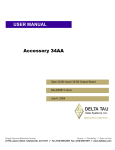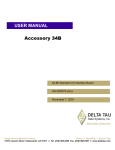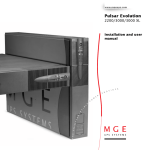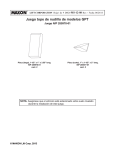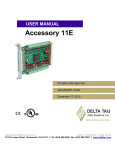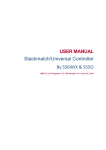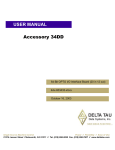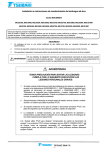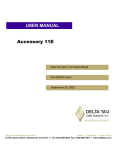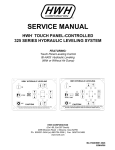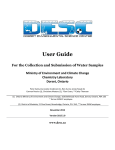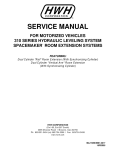Download ACC-34A_____________________________Opto 32
Transcript
^1 USER MANUAL ^2 Accessory 34A ^3 Opto 32-Bit Input/ 32-Bit Output Board ^4 3Ax-602350-xUxx ^5 October 16, 2003 Single Source Machine Control Power // Flexibility // Ease of Use 21314 Lassen Street Chatsworth, CA 91311 // Tel. (818) 998-2095 Fax. (818) 998-7807 // www.deltatau.com Copyright Information © 2003 Delta Tau Data Systems, Inc. All rights reserved. This document is furnished for the customers of Delta Tau Data Systems, Inc. Other uses are unauthorized without written permission of Delta Tau Data Systems, Inc. Information contained in this manual may be updated from time-to-time due to product improvements, etc., and may not conform in every respect to former issues. To report errors or inconsistencies, call or email: Delta Tau Data Systems, Inc. Technical Support Phone: (818) 717-5656 Fax: (818) 998-7807 Email: [email protected] Website: http://www.deltatau.com Operating Conditions All Delta Tau Data Systems, Inc. motion controller products, accessories, and amplifiers contain static sensitive components that can be damaged by incorrect handling. When installing or handling Delta Tau Data Systems, Inc. products, avoid contact with highly insulated materials. Only qualified personnel should be allowed to handle this equipment. In the case of industrial applications, we expect our products to be protected from hazardous or conductive materials and/or environments that could cause harm to the controller by damaging components or causing electrical shorts. When our products are used in an industrial environment, install them into an industrial electrical cabinet or industrial PC to protect them from excessive or corrosive moisture, abnormal ambient temperatures, and conductive materials. If Delta Tau Data Systems, Inc. products are directly exposed to hazardous or conductive materials and/or environments, we cannot guarantee their operation. Accessory 34A Table of Contents INTRODUCTION .....................................................................................................................................................1 CONNECTORS.........................................................................................................................................................3 J1 (JTHW)...............................................................................................................................................................3 TB1..........................................................................................................................................................................3 TB2..........................................................................................................................................................................3 TB3..........................................................................................................................................................................3 TB4..........................................................................................................................................................................3 TB5..........................................................................................................................................................................3 TB6..........................................................................................................................................................................3 TB7..........................................................................................................................................................................4 TB8..........................................................................................................................................................................4 TB9..........................................................................................................................................................................4 MULTIPLEX ADDRESS MAP ...............................................................................................................................5 SW1 DIP Switch Setting .....................................................................................................................................6 INPUT AND OUTPUT PORTS ...............................................................................................................................7 M-VARIABLE ASSIGNMENTS.............................................................................................................................9 PROCESSING ACC-34X INPUTS & OUTPUTS ...............................................................................................11 WHEN TO ACCESS ACC-34X .............................................................................................................................13 ACC-34X SETUP ....................................................................................................................................................15 Image Word Variables ..........................................................................................................................................15 PMAC Location of Image Words .........................................................................................................................15 Open Memory Standard PMAC: ......................................................................................................................15 DPRAM Standard PMAC:................................................................................................................................15 Turbo PMAC Location of Image Words...............................................................................................................15 Open Memory Turbo PMAC.............................................................................................................................15 DPRAM Standard Turbo PMAC ..........................................................................................................................16 Preventing Conflicts in Output Image Words .......................................................................................................16 Image Words.....................................................................................................................................................18 Individual Pieces of Image Words....................................................................................................................18 USING ACC-34 WITH MACRO STATION........................................................................................................21 MS{anynode},MI90: Multiplexer Port #1 Read Address ................................................................................22 MS{anynode},MI91: Multiplexer Port #1 Read Value ....................................................................................22 MS{anynode},MI92: Multiplexer Port #1 Write Address................................................................................22 MS{anynode},MI93: Multiplexer Port #1 Write Value ...................................................................................22 MS{anynode},MI94: Multiplexer Port #2 Read Address ................................................................................22 MS{anynode},MI95: Multiplexer Port #2 Read Value ....................................................................................23 MS{anynode},MI96: Multiplexer Port #2 Write Address................................................................................23 MS{anynode},MI97: Multiplexer Port #1 Write Value ...................................................................................23 POWER SUPPLY AND OPTO-ISOLATION CONSIDERATIONS ................................................................25 ACC-34A and Its Option 1 (Custom Order) .....................................................................................................25 Output Configuration .......................................................................................................................................25 Input Configuration ..........................................................................................................................................26 Input Polarity Jumpers Setup ...........................................................................................................................26 Watch Dog Timer (Role of Jumper E22) ..............................................................................................................27 CONNECTOR PINOUTS ......................................................................................................................................29 J1 (26-Pin Header)...........................................................................................................................................29 TB1 (10-pin Terminal Block)............................................................................................................................29 Table of Contents i Accessory 34A TB2 (10-pin Terminal Block)............................................................................................................................30 TB3 (10-Pin Terminal Block) ...........................................................................................................................30 TB4 (10-Pin Terminal Block) ...........................................................................................................................30 TB5 (10-Pin Terminal Block) ...........................................................................................................................31 TB6 (10-Pin Terminal Block) ...........................................................................................................................31 TB7 (10-Pin Terminal Block) ...........................................................................................................................32 TB8 (10-Pin Terminal Block) ...........................................................................................................................32 TB9 (2-Pin Terminal Block) .............................................................................................................................32 PMAC ACC-34A OPTION 1 (CUSTOM ORDER) FORM................................................................................33 DIAGRAMS.............................................................................................................................................................35 ii Table of Contents Accessory 34A INTRODUCTION PMAC's Accessory 34A(ACC-34A) is a general-purpose discrete input/output (I/O) board. ACC-34A provides 32 lines of optically isolated inputs and 32 lines of optically isolated outputs. Port A contains the 32 input lines (AI0 to AI31). Port B contains the 32 output lines (BO0 to BO31). The actual I/O Reads and Writes are carried out using a special form of M-variables, which will be described later. ACC-34A is one of a series of I/O accessories for PMAC that uses the JTHW connector. Others are: ACC-34 ACC-34B ACC-18 ACC-8D Option 7 ACC-8D Option 8 The Opto 64-bit Input/Output board The 64-bit Standard Opto I/O Interface board The Thumbwheel Multiplexer board The Resolver to Digital Converter board The Absolute Encoder Interface board All of the above accessories use the JTHW multiplex address scheme, and several of them may be daisychained to a single PMAC. For enhanced noise reduction and long distance installation, Accessories 35A and 35B provide differential buffer capabilities for the JTHW signals. The use of the long distance buffer pair (ACC-35A and ACC-35B) is recommended whenever the required cable length between PMAC and ACC-34x is over 3 meters (10 feet). Up to 32 ACC-34As may be connected to a single PMAC, which gives a possible 1024 input and 1024 output lines in addition to those available on the PMAC board and on the parallel I/O expansion board(s) (ACC-14). Accessory 34 communicates to PMAC via its JTHW connector through the supplied flat cable. ACC-34A output drivers are organized in a set of four 8-bit groups. Each group (each byte) may be ordered with either current sourcing drivers (default) or with current sinking drivers. The default configuration of this accessory board uses UDN2981 current sourcing drivers for the four 8-bit output groups. With this configuration, the current drawn from each output line should be limited to 100 mA at voltage levels between 12 and 24 volts. Custom orders (ordered as ACC-34A Option 1) are available for current sinking applications. In current sinking configurations, one ULN2803 driver is used for each 8-bit output group. Each open collector output line can sink up to 100 mA when pulled up to a voltage level between 12 to 24 volts (external pull-up resistors are not supplied). When this accessory is ordered with its Option 1, the mixing of current sourcing and sinking drivers is possible (in 8-bit groups). ACC-34A input buffers are also organized in a set of four 8-bit groups. Each group (each byte) uses one ULN2802 driver as the input buffer. Both current sourcing and sinking inputs are accommodated by the appropriate setting of the pertinent jumpers and diode groups as explained later in this Manual. The default setting is for current sourcing configurations on all inputs. ACC-34A also supports a local watchdog timer feature independent of PMAC’s. The operation of this feature is explained at the end of this manual (see also the enclosed schematic). Introduction 1 Accessory 34A 2 Introduction Accessory 34A CONNECTORS Refer to the layout diagram of ACC-34A for the location of the connectors on the board. A pin definition listing for each connector begins on page 28 of this Manual. J1 (JTHW) This 26-pin Header provides the link between PMAC’s JTHW (J3) and ACC-34A. Using the supplied flat cable, PMAC’s J3 should be connected to J1. Through this connector, PMAC sets the outputs and reads the inputs. The power for the processor side of the opto-isolation circuitry is provided from the PMAC board through this connector. For the connection of multiple ACC-34As to a single PMAC, a daisy-chain cable is required (consult Delta Tau for a Special Order on the daisy-chain cable). A daisy-chain cable is also required if one or more Thumbwheel Multiplexer boards (ACC-18) or R-to-D boards (ACC-8D Opt. 7) are used in conjunction with one or more ACC-34As. TB1 This 10-pin Terminal Block is used for the connection to the first set of eight input lines (AI0 to AI7). A separate power supply for the pull-up/down resistors of AI0 to AI7 should be brought in through this connector (15 to 24V, 70 mA). TB2 This 10-pin Terminal Block is used for the connection to the second set of eight input lines (AI8 to AI15). In addition, a separate power supply for the pull-up/down resistors of AI8 to AI15 should be brought in through this connector (15 to 24V, 70 mA). TB3 This 10-pin Terminal Block is used for the connection to the third set of eight input lines (AI16 to AI23). A separate power supply for the pull-up/down resistors of AI16 to AI23 should be brought in through this connector (15 to 24V, 70 mA). TB4 This 10-pin Terminal Block is used for the connection to the fourth set of eight input lines (AI24 to AI31). A separate power supply for the pull-up/down resistors of AI24 to AI31 should be brought in through this connector (15 to 24V, 70 mA). TB5 This 10-pin Terminal Block is used for the connection to the first set of eight output lines (BO0 to BO7). A separate power supply for BO0 to BO7 should be brought in through this connector. In the sourcing configuration, this supply will be used to drive the loads on the eight lines (up to 800 mA maximum at 24V). In the sinking configuration, the current requirement from this power supply is minimal (approx. 70 mA). TB6 This 10-pin Terminal Block is used for the connection to the second set of eight output lines (BO8 to BO15). A separate power supply for BO8 to BO15 should be brought in through this connector. In the sourcing configuration, this supply will be used to drive the loads on all eight lines (up to 800 mA maximum at 24V). In the sinking configuration, the current requirement from this power supply is minimal (approx. 70 mA). Connectors 3 Accessory 34A TB7 This 10-pin Terminal Block is used for the connection to the third set of eight output lines (BO16 to BO23). A separate power supply for BO16 to BO23 should be brought in through this connector. In the sourcing configuration, this supply will be used to drive the loads on all the eight lines (up to 800 mA maximum at 24V). In the sinking configuration, the current requirement from this power supply is minimal (approx. 70 mA). TB8 This 10-pin Terminal Block is used for the connection to the fourth set of eight output lines (BO24 to BO31). A separate power supply for BO24 to BO31 should be brought in through this connector. In the sourcing configuration, this supply will be used to drive the loads on all eight lines (up to 800 mA maximum at 24V). In the sinking configuration, the current requirement from this power supply is minimal (approx. 70 mA). TB9 This is a 2-pin terminal block used to bring in the power supply (12-24V) for logic circuits on the I/O side of the opto-isolation circuitry. For proper operation of the board, this power supply must be brought in through TB9. 4 Connectors Accessory 34A MULTIPLEX ADDRESS MAP Each ACC-34 occupies eight bytes of address space on the PMAC’s JTHW multiplex memory space. This memory space is 8-bits wide, which provides the ability to daisy chain 32 (256/8) ACC-34XS together (or a combination of ACC-34XS, ACC-18s and ACC-8D OPT7s). The 5-bit DIP switch, SW1, determines the address of each ACC-34X board on the allocated memory space. Port A occupies the base address (i.e. bytes 0, 8, 16 etc.) and Port B occupies the base address plus 4 (i.e. bytes 4, 12, 20 etc.). The following table shows how SW1 should be set for one or more ACC-34X boards connected to the same PMAC. Multiplex Address Map 5 Accessory 34A SW1 DIP Switch Setting Board # Byte (Port A & Port B) 5 4 3 2 1 #1 0&4 ON ON ON ON ON #2 8 & 12 ON ON ON ON OFF #3 16 & 20 ON ON ON OFF ON #4 24 & 28 ON ON ON OFF OFF #5 32 & 36 ON ON OFF ON ON #6 40 & 44 ON ON OFF ON OFF #7 48 & 52 ON ON OFF OFF ON #8 56 & 60 ON ON OFF OFF OFF #9 64 &68 ON OFF ON ON ON #10 72 & 76 ON OFF ON ON OFF #11 80 & 84 ON OFF ON OFF ON #12 88 &92 ON OFF ON OFF OFF #13 96 & 100 ON OFF OFF ON ON #14 104 & 108 ON OFF OFF ON OFF #15 112 & 116 ON OFF OFF OFF ON #16 120 & 124 ON OFF OFF OFF OFF #17 128 & 132 OFF ON ON ON ON #18 136 & 140 OFF ON ON ON OFF #19 144 & 148 OFF ON ON OFF ON #20 152 & 156 OFF ON ON OFF OFF #21 160 & 164 OFF ON OFF ON ON #22 168 & 172 OFF ON OFF ON OFF #23 176 & 180 OFF ON OFF OFF ON #24 184 &188 OFF ON OFF OFF OFF #25 192 & 196 OFF OFF ON ON ON #26 200 & 204 OFF OFF ON ON OFF #27 208 & 212 OFF OFF ON OFF ON #28 216 & 220 OFF OFF ON OFF OFF #29 124 & 228 OFF OFF OFF ON ON #30 232 & 236 OFF OFF OFF ON OFF #31 240 & 244 OFF OFF OFF OFF ON #32 248 & 252 OFF OFF OFF OFF OFF This table shows the daisy-chain board address relationship with respect to the 5-bit (SW1) DIP position setting. Note: ON=CLOSED, OFF=OPEN. To turn "off" a switch, push down on the "open" side. To turn "on" a switch, push down on the "numbered" side. 6 Multiplex Address Map Accessory 34A INPUT AND OUTPUT PORTS Port A is always configured as an input port, and the output lines are driven by writing to port B. The input and the output lines can be read or written to using TWS type M-variables. Once the correct Mvariable definition assignment is done, one may use these M-variables in the usual ways (e.g. motion programs, PLC programs, etc.). Efficient programming techniques for TWS M-variable processing are discussed below. Jumpers E1 through E8 and E17 through E21 together with the diode packs DP1 to DP4 determine the sinking/sourcing characteristics of the input port (see below). For sourcing a high level on, an input line is read as binary 1 (positive logic). For sinking a high level on, an input line is read as binary 0 (negative logic). Jumpers E9 through E16 together with drivers U17 through U20 determine the sinking/sourcing characteristic of the output port (see below). For a sourcing setup, writing a binary 1 generates a high level on the corresponding output line (positive logic). For a sinking setup, writing a binary 1 turns on the corresponding open collector transistor output, and this in turn switches on the output (negative logic). Input and Output Ports 7 Accessory 34A 8 Multiplex Address Map Accessory 34A M-VARIABLE ASSIGNMENTS There is a special format 32-bit wide M-variable for reading the data from, and writing the data to an ACC-34 card: TWS. Note: This special M-variable definition is implemented in PMAC's firmware with a version number equal to or higher than 1.13. In version 1.14D, the TWS format was modified in its address designation field to prevent unintentional reads from an output port or unintentional writes to an input port. If your PROM version is between 1.13 to 1.14C, you may request a free PROM update to version 1.14D or above. M{constant}->TWS:{m-plex} ;Serial Thumbwheel Multiplexer M;Variable Definition This command causes PMAC to define the specified M-variable or range of M-variables to point to a 32bit word of input or output serially multiplexed on the "thumbwheel" port on an Accessory 34x board. Note: The individual bits of the "thumbwheel" port on an Accessory 34x board can not be directly assigned to an M-variable. Only 32-bit words (ports) of input or output can be accessed. The address on the multiplex port specified here must match the address set by the DIP switch on the ACC-34x board. The ACC-34x manual contains a table listing all of the possibilities. The entire word must either be all input or all output. On power-up/reset, all ACC-34x words are software-configured as inputs (if the hardware is configured for outputs, all outputs will be OFF -- pulled up to the supply voltage). Any subsequent write operation to an I/O word on the port with one of these M-variables automatically makes the entire word an output word with individual bits ON or OFF, as determined by the value written to the word. Any subsequent read operation of a word that has been set up for output configures, or tries to configure, the entire word into an input word, which turns any hardware outputs OFF. Therefore, it is important that the following rules be observed when working with these M-variables: Never use this M-variable form to write to a word that is set up for inputs. Never use this M-variable form to read from a word that is set up for outputs The best procedure for using TWS M-variables in a program is as follows: The input word (TWS Mvariable) should be copied into its image variable at the beginning of a sequence of operations. The operations can then be done on the image variable without requiring PMAC to actually read or write to the I/O port for each operation. The output word is first "assembled" into its image variable, and then copied to the actual output word once at the end of a sequence of operations. This procedure will allow the most efficient and flexible use of TWS M-variables. Note This type of variable can only be used in background tasks (PLCs and PLCCs 1-31). They cannot be used in foreground tasks (motion programs and PLC and PLCC 0). For an input port, {m-plex} is a legal byte number (from column 2 of Table 1) plus 1. Any attempt to write to a TWS type M-variable defined with bit zero of its address set to 1, is automatically prevented by PMAC's firmware. For an output port, {m-plex} is a legal byte number (from column 2 of Table 1) plus M-Variable Assignments 9 Accessory 34A 2. An attempt to read a TWS type M-variable defined with bit one of its address set to 1, returns zero, and the actual read is prevented by PMAC's firmware. Note Individual bits cannot be directly assigned to an M-variable of this type. Rather, banks of 32 bits (ports) can be assigned to M-variables. Example: To address Port A (bits 0 to 31) of board #1 as an input using M100, use the following definition: Board # Byte (Port A & Port B) #1 0&4 M100->TWS:1 5 ON 4 ON 3 ON 2 ON 1 ON ; Port A (AIO 0-31) of an ACC-34 with SW1 switches all ON ; assigned for read only (1=0+1) Similarly, to address Port B of the same board #1 as an output using M101, use the following definition: M101->TWS:6 ; Port B (BIO 0-31) of an ACC-34 with SW1 switches all ON ; assigned for write only (4+2=6) To address Port A of board #6 as an input using M300, use the following definition: Board # Byte(Port A & Port B) #6 40 & 44 M300->TWS:41 5 ON 4 ON 3 OFF 2 ON 1 OFF ; Port A (AIO 0-31) of an ACC-34 with SW1 switches ; assigned for read only (41=40+1) Note A 32-bit Read or a 32-bit Write to an individual port takes approximately 64 microseconds of time in the PMAC's background time slot. As a result, excessive and unnecessary references to TWS type M-variables is not recommended (see below for efficient ACC-34x I/O processing). Note TWS type M-variable definition addresses which point to the base address directly (e.g. M300->TWS:40) are still valid (i.e. they do not generate error). However, their use is very strongly discouraged. This is because both reads and writes are enabled when the least significant and the next least significant addresses bits are both zero (e.g. hexadecimal 40 = 01000000 in binary). In this situation, any accidental read of an output port (say via the Executive programs watch window) will cause all the output transistors to be turned off (outputs pulled to the supply voltage)! Alternatively, writing to an input port will automatically reconfigure it to an output port! It is therefore safer and more predictable when bits 0 & 1 of the M-variable definition are intentionally used to disable either the read function or the write function. 10 M-Variable Assignments Accessory 34A PROCESSING ACC-34X INPUTS & OUTPUTS Because the PMAC interface to the Accessory 34 family of I/O boards (ACC-34x) is by full, 32-bit words transmitted serially (even when access to only a single bit is desired), the user must consider carefully how the interface is done and how frequently. Care must also be taken to work efficiently with the data so that PMAC is not bogged down with slow serial reads and writes, and time-consuming logic to assemble and disassemble I/O words. The recommended strategy is to keep "images" of each input or output word in PMAC’s internal memory, or in the dual-ported RAM. The input words are copied into their image words, and the output words are copied from their image words. Most program operations deal with these image words; this way, slow transfer to or from an ACC-34x board is performed less frequently. During the act of copying, bit inversion can also be performed with the exclusive-or function. Processing ACC-34x Inputs & Outputs 11 Accessory 34A 12 Processing ACC-34x Inputs & Outputs Accessory 34A WHEN TO ACCESS ACC-34X The actual reads and writes for an ACC-34x board can only be done in a background PLC program (PLC 1-31) or through on-line commands, which are executed between PLC programs. Motion programs and PLC 0 cannot directly access this I/O (they can work only with the image words). Reading an input word from an ACC-34x is simply a question of using the TWS-form M-variable for that word on the right side of an equation. Usually, this operation simply copies the input word into its internal image variable. Similarly, writing an output word to an ACC-34x involves using the M-variable for that word on the left side of an equation, typically just copying it from its internal image word. Most users will treat ACC-34x I/O the same way that a traditional PLC treats its I/O; all of the inputs are read at the beginning of a PLC software scan, and all of the outputs are written to at the end of the scan. In between, all the processing of the variables is done while working with the internal image words. It is possible to make the write operation to the output word conditional on a change in the image word for the output from the previous scan, but the time involved in making the decision and storing each scan's value is about the same as the actual writing to the output. When to Access ACC-34x 13 Accessory 34A 14 When to Access ACC-34x Accessory 34A ACC-34X SETUP For the purpose of ACC-34x setup, the following example will demonstrate how to utilize 32 inputs and 32 outputs of an ACC-34x. Let us first define three variables that will be used during the ACC-34x I/O procedure. Actual Word Variable Image Word Variable Image Bit Variable Variable which is read or written to by ACC-34x & PMAC Variable assigned set equal to (Image) actual word variable Single bit of image word variable Image Word Variables It is best to use fixed-point M-variables as the internal image variables for the I/O words. When this is done, a single M-variable representing the entire I/O word can be used for the copying operation. Then separate M-variables can be used to access individual bits or segments of the image word. Use of these smaller M-variables allows PMAC's efficient firmware to do the masking and logic necessary to pick out portions of the I/O word, rather than slower user program code. PMAC Location of Image Words Where should these internal image variables reside in PMAC's memory? Open Memory Standard PMAC: For a standard PMAC with no DPRAM on board, the image word will be in an otherwise unused double register in PMAC's own memory. There are several places to find unused registers. There are 16 open registers that are set to zero automatically on power-up at PMAC addresses $0770 to $077F. There are 16 more open registers, whose values are held when power is off at PMAC addresses $07F0 to $07FF. It is possible to use the registers of otherwise unused P and Q-variables for this purpose. These registers should be accessed with fixed-point M-variables, not floating-point P or Q-variables. A double fixed-point register in PMAC's internal memory is defined by the D format of M-variable (e.g. M61->D:$07F0). This is a 48-bit register (only the low 32 bits will be used). The low 24 bits of the I/O will be in the Y-memory, and the high 8 bits of the I/O will be in the low 8 bits of X-memory. DPRAM Standard PMAC: If the system has dual-ported RAM, it is probably best to use a 32-bit register in DPRAM. This way, the host computer always has immediate access to the I/O. In fact, it is possible to use PMAC just as a passthrough between the host computer and the ACC-34x boards, letting the host computer do all the processing. A 32-bit fixed-point register in DPRAM is defined by the DP format of M-variable (e.g. M60-> DP:$DF00). This type of variable occupies the low 16 bits (bits 0 to 15) of PMAC Y-memory, and the low 16 bits of PMAC X-memory at the same address, with the less significant bits in Y-memory. It appears to the host computer as two 16-bit registers at consecutive even addresses, with the less significant bits at the lower address. Turbo PMAC Location of Image Words Open Memory Turbo PMAC For a Turbo PMAC with no DPRAM on board, the image word will be in an unused double register in Turbo PMAC's own memory. There are several places to find unused registers. There are 16 open registers that are automatically set to zero on power-up at Turbo PMAC addresses $0010F0 to $0010FF. Also, it is possible to use the registers of otherwise unused P and Q-variables for this purpose. ACC-34x Setup 15 Accessory 34A These registers should be accessed with fixed-point M-variables, not floating-point P or Q-variables. A double fixed-point register in PMAC's internal memory is defined by the D format of M-variable (e.g. M80->D:$0010F0). This is a 48-bit register (only the low 32 bits will be used). The low 24 bits of the I/O will be in the Y-memory, and the high 8 bits of the I/O will be in the low 8 bits of X-memory. When working with the ACC-34x I/O with this method of using fixed-point image variables, the only software overhead is the actual copying between image and I/O. Including program interpretation time, this amounts to about 100 microseconds per 32-bit word. Aside from this, working with the I/O through the image words is at least as fast as direct (parallel) PMAC I/O. There is a potential latency of a full PLC scan on the actual I/O, which must be respected. Many systems will have a few critical I/O points that cannot tolerate this latency; these typically use PMAC's JOPTO port or ACC-14 I/O for these timecritical points, then use ACC-34x for I/O that do not need to be so fast. DPRAM Standard Turbo PMAC If the system has dual-ported RAM (Option 2 is required), it is probably best to use a 32-bit register in DPRAM. This way, the host computer always has immediate access to the I/O. In fact, it is possible to use PMAC just as a pass-through between the host computer and the ACC-34x boards, letting the host computer do all the processing. A 32-bit fixed-point register in DPRAM is defined by the DP format of M-variable (e.g. M80-> DP:$060000). This type of variable occupies the low 16 bits (bits 0 to 15) of PMAC Y-memory, and the low 16 bits of PMAC X-memory at the same address, with the less significant bits in Y-memory. It appears to the host computer as two 16-bit registers at consecutive even addresses, with the less significant bits at the lower address. Preventing Conflicts in Output Image Words Care must be taken if tasks of different priority levels are trying to write to the same output image word, or if both the host computer and PMAC are trying to write to the same DPRAM output image word. If the proper techniques are not used, occasional output changes will not be executed, and because of the intermittent nature of the problem, it will be very difficult to diagnose. If the application has two priority levels or two computers that write to the same ACC-34x output word, separate partial image words must be used. These words combined as the output word is sent. Note There is no conflict in having different tasks or different processors read from the same input word. Remember that a computer cannot actually write to less than a word of memory at a time, even if it only wants to change one bit. In PMAC the word length is 24 bits; for the DPRAM, it is 16 bits. If a computer wants to change less than a full word, it must read the full word, modify the bits it wants with "mask words", then write back the full word. There are two priority levels in PMAC that can write to these image words: the foreground level, which includes all of the motion programs and PLC 0; and the background level, which includes PLCs 1-31 and on-line commands. The problem can occur when a higher priority task interrupts a lower priority task that is in the middle of changing the image word with a read-modify-write operation. When the lower priority task resumes, it will undo the changes made by the higher priority task. Similarly, if the image word is in the DPRAM, and one side starts its read-modify-write cycle on the word but does not finish it before the other side starts its own cycle, the side that starts later can undo the changes made by the side that starts first. Note 16 ACC-34x Setup Accessory 34A Two tasks at the same priority level cannot interrupt each other; one will always finish an operation before the other starts. Therefore, there is no need to worry about two motion programs writing to the same image word; or a motion program and PLC 0; because these tasks are at the same priority level. Similarly, there is no need to worry about two background PLC programs writing to the same image word, or a background PLC and on-line commands.) To prevent this possible conflict, the different priority levels or different processors must use different image words, even if they each represent only a part of the same total output word. These partial words are then combined in the act of writing to the actual output word. The simplest way to split an image word is to use the natural X-memory vs. Y-memory split in PMAC's memory. If you are using a double word in PMAC's internal memory, you can reserve the 24 bits in Ymemory for one priority level, and the 8 bits in X-memory for the other. If you are using the DPRAM, you can reserve the 16 bits in Y-memory for one processor or priority level, and the 16 bits in X-memory for another. If you do this, no special techniques need to be used. On PMAC, simply write to the partial words with a X or Y format M-variable; PMAC will automatically do the read-modify-write cycle without touching the other part of the word. On the host computer, access the DPRAM register with the short (16-bit) integer format, not the long. However, if you cannot arrange your split in this fashion, you must create separate "overlapping" image words and explicitly combine them. Example: Take a system where the low 12 bits will be written to by background PLCs and the high 20 bits will be written to by motion programs. Create two separate image words: one for each priority level, and the actual output word: PMAC M101->D:$0770 M102->D:$0771 Turbo PMAC M81->D:$0010F0 M82->D:$0010F1 M103->TWS:6 M83->TWS:6 Comments ; Image word for PLC programs (background) ; Image word for motion programs (foreground) ; ACC-34x output word; write-only We also define single-bit M-variables to parts of these same internal addresses: at Y:$0770 ($0010F0 for Turbo), bits 0 to 11 for the PLCs; then at Y:$0771($0010F1 for Turbo), bits 12 to 23, and X:$0771($0010F1 for Turbo), bits 0 to 7 for the motion programs. At the end of a PLC scan, to create the actual output word on an ACC-34x from the image words, we would use the program statement: M103 = (M101 & $00000FFF) | (M102 & $FFFFF000) The bit-by-bit AND (&) operations make sure no falsely set bits in unused portions of the image words get into the output word. They are not strictly necessary if the unused bits can be guaranteed to be zero. The bit-by-bit OR ( | ) operation combines the word. The assignment of the resulting value to M103 causes it to be written to the ACC-34x. If you want to be able to write to the same bit of an output image word with two different priority levels or processors, one of the tasks must do so indirectly by writing into a holding register. The other task must take this holding register and transfer the bit value into the image word. This task must decide what to do in case of any conflict (i.e. one task wants to clear the bit, and the other wants to set it). The following example illustrates the method of working with ACC-34x I/O. It describes the procedure for memory allocation, for the inputs, and for the outputs (Image Word Variables) that will work with either Dual Ported RAM or PMAC memory locations Example: This example shows the image variables both in DPRAM and several places in internal memory. In a real application, a single location range would probably be chosen. ACC-34x Setup 17 Accessory 34A Set-up and Definitions: ; Actual ACC-34 I/O Words M1000->TWS:1 ; First side of first ACC-34x board; an input here ; Location is at port address 0; added 1 for read only M1002->TWS:6 ; Second side of first ACC-34x board; an output here ; Location is at port address 4 added 2 for write only M1004->TWS:9 ; First side of second ACC-34x board; an input here ; Location is at port address 8; added 1 for read only M1006->TWS:14 ; Second side of second ACC-34x board; an output here ; Location is at port address 12; added 2 for write ; only Image Words PMAC M1001->DP:$D800 M1003->D:$0770 Turbo PMAC M1001->DP:$060800 M1003->D:$0010F0 M1005->D:$07F0 * Power-down hold registers are not available in Turbo PMAC M1005->D:$0061F0 M1007->D:$13FF M1007->D:$0063FF Comments ; 32-bit fixed-point DPRAM register ; 48-bit fixed-point register, set to zero on ; power-up ; PMAC: 48-bit fixed-point register, value held ; through power-down ; Turbo PMAC: use this register for Pvariable, ; treated as 48-bit fixed point value ; Register for P1023, treated as 48-bit ; fixed-point value * User Buffer Storage Space is same for the battery backed Turbo PMAC. Individual Pieces of Image Words For PMAC Memory Locations PMAC M1000->TWS:1 M1001->D:$770 M800->Y:$770,0 M801->Y:$770,1 M802->Y:$770,2 M822->Y:$770,22 M823->Y:$770,23 M824->X:$770,0 M825->X:$770,1 M830->X:$770,6 M831->X:$770,7 PMAC M1002->TWS:6 M1003->D:$771 M900->Y:$771,0 M901->Y:$771,1 902->Y:$771,2 18 Port A Setup: Read Only Turbo PMAC M1000->TWS:1 M1003->D:$0010F0 M800->Y:$0010F0,0 M801->Y:$0010F0,1 M802->Y:$0010F0,2 M822->Y:$0010F0,22 M823->Y:$0010F0,23 M824->X:$0010F0,0 M825->X:$0010F0,1 M830->X:$0010F0,6 M831->X:$0010F0,7 Port B Setup: Write Only Turbo PMAC M1002->TWS:6 M1003->D:$0010F1 M900->Y:$0010F1,0 M901->Y:$0010F1,1 M902->Y:$0010F1,2 Comments Port A (AIO 0-31) Image word for PLC’s Bit0 (LSB) Bit1 Bit2 Bit22 Bit23 Bit24 Bit25 Bit30 Bit31 (MSB) Comments Port B (BIO 0-31) Image word for PLC’s Bit0 (LSB) Bit1 Bit2 ACC-34x Setup Accessory 34A 922->Y:$771,22 M922->Y:$0010F1,22 923->Y:$771,23 M923->Y:$0010F1,23 924->X:$771,0 M924->X:$0010F1,0 925->X:$771,1 M925->X:$0010F1,1 M930->X:$771,6 M930->X:$0010F1,6 M931->X:$771,7 M931->X:$0010F1,7 For PMAC Dual Ported RAM Locations PMAC M1000->TWS:1 M1001->DP:$D800 M800->Y:$D800,0 M801->Y:$D800,1 M802->Y:$D800,2 M814->Y:$D800,14 M815->Y:$D800,15 M816->X:$D800,0 M817->X:$D800,1 M830->X:$D800,14 M831->X:$D800,15 PMAC M1002->TWS:6 M1003->DP:$D801 M900->Y:$D801,0 M901->Y:$D801,1 M902->Y:$D801,2 M914->Y:$D801,14 M915->Y:$D801,15 M916->X:$D801,0 M917->X:$D801,1 M930->X:$D801,14 M931->X:$D801,15 Programs: reset Port A Setup: Read Only Turbo PMAC M1000->TWS:1 M1001->DP:$060800 M800->Y:$060800,0 M801->Y:$060800,1 M802->Y:$060800,2 M814->Y:$060800,14 M815->Y:$060800,15 M816->X:$060800,0 M817->X:$060800,1 M830->X:$060800,14 M831->X:$060800,15 Port B Setup: Write Only Turbo PMAC M1002->TWS:6 M1003->DP:$060801 M900->Y:$060801,0 M901->Y:$060801,1 M902->Y:$060801,2 M914->Y:$060801,14 M915->Y:$060801,15 M916->X:$060801,0 M917->X:$060801,1 M930->X:$060801,14 M931->X:$060801,15 Bit22 Bit23 Bit24 Bit25 Bit30 Bit31 (MSB) Comments Port A (AIO 0-31) Image word for PLC’s Bit0 (LSB) Bit1 Bit2 Bit14 Bit15 Bit16 Bit17 Bit30 Bit31 (MSB) Comments Port B (BIO 0-31) Image word for PLC’s Bit0 (LSB) Bit1 Bit2 Bit14 Bit15 Bit16 Bit17 Bit30 Bit31 (MSB) ; "Reset" PLC program that only runs once on power-up or OPEN PLC 1 CLEAR M1003=0 M1007=0 ... DISABLE PLC 1 CLOSE ; Clear output image word to make sure all outputs off ; Ditto ; To make sure this only runs once on power-up/reset ;PLC program to copy the inputs into image words at beginning of each scan OPEN PLC 2 CLEAR M1001=M1000 ; Copy first input word into its image register M1005=M1004^$FFFFFFFF ; Copy second input word into its image register, ; inverting ... ACC-34x Setup 19 Accessory 34A CLOSE ; PLC program that works with individual bits of image words OPEN PLC 3 CLEAR IF (M100=1 AND M101=0 AND P43>50) M301=1 ELSE M301=0 ENDIF ... CLOSE ; PLC program that copies image words to outputs at end of scan OPEN PLC 31 CLEAR M1002=M1003 M1004=M1005^$FFFFFFFF 20 ; Copy first output image word to ACC-34x ; Copy second output image word to ACC-34x, inverting ACC-34x Setup Accessory 34A USING ACC-34 WITH MACRO STATION Two ACC-34’s could be used at each MACRO Station in the ring. The MACRO Station has eight variables used for this purpose: MI90, MI91, MI92, MI93, MI94, MI95, MI96, and MI97. Each ACC-34 Port has two variables associated with it. The first variable is the multiplexer port address, and the second is the actual input or output word. To read or write to these variables, special MACRO Station read and write commands (buffered and on-line) can be used to read and write to and from the Ultralite or Turbo Ultralite. Port Address MI90 MI92 MI94 MI96 Actual Word MI91 MI93 MI95 MI97 Type Input – Read Only Output – Write Only Input – Read Only Output – Write Only These variables are implemented on MACRO Station firmware versions V1.111 and newer. Example: The user wants two ACC-34AAs connected to the multiplexer port on the MACRO station for 128-bits of I/O. The SW1 settings for the boards in this example are shown below. Board # Byte (Port A & Port B) #1 0&4 #2 8 & 12 5 ON ON 4 ON ON 3 ON ON 2 ON ON 1 ON OFF Based on the switch settings, the port address settings would be: MSn, MSn, MSn, MSn, MI90=1 MI92=6 MI94=9 MI96=14 ; ; ; ; Port Port Port Port A B A B Board Board Board Board 1 1 2 2 The user could then read and write from and to the MACRO station using the following definitions and commands: PMAC Ultralite M1000->D:$07F0 Turbo PMAC Ultralite M1000->D:$0061F0 M1001->D:$07F1 M1001->D:$0061F1 M1002->D:$07F2 M1002->D:$0061F2 M1003->D:$07F3 M1003->D:$0061F3 Comments ; input image word for ; Ultralite ; board 1 ; output image word for ; Ultralite board 1 ; input image word for ; Ultralite board 2 ; output image word for ; Ultralite board 2 The following commands could be used as either on-line commands for testing, or they could be used in your PLC or motion program as buffer commands: MSRn, MSWn, MSRn, MSRn, MI91, MI93, MI95, MI97, M1000 M1001 M1002 M1003 ; ; ; ; Using ACC-34 with MACRO Station Reads the value of MSn, MI91 to M1000 Writes the value of M1001 to MSn, MI93 Reads the value of MSn, MI95 to M1002 Reads the value of M1003 to MSn, MI97 21 Accessory 34A MS{anynode},MI90: Multiplexer Port #1 Read Address Range: $00 - $FF Units: MACRO Station Multiplexer Port Addresses Default: $00 MI90 specifies the address on the MACRO Station’s JTHW multiplexer port of a 32-bit input port on an ACC-34 family I/O board. If MI90 is set greater than 0, the 32 input values will be copied periodically into Station variable MI91. MI90 must match the multiplexer port address of the ACC-34 board from which the inputs are to be read, as set by the SW1 DIP switch bank on the board. For the regular input port, the value of MI90 should be set 1 greater than the base address of the board set by the DIP switch bank. For the ACC-34C’s optional second 32-bit input port, the value of MI94 should be set 3 greater than the base address. MS{anynode},MI91: Multiplexer Port #1 Read Value Range: $00000000 - $FFFFFFFF Units: Individual bits MI91 contains the 32-bit value read from the input port of the ACC-34 whose multiplexer port address is specified by MI90. Each bit represents one input from the port. Bit n of MI91 represents Input n on the port. MS{anynode},MI92: Multiplexer Port #1 Write Address Range: $00 - $FF Units: MACRO Station Multiplexer Port Addresses Default: $00 MI92 specifies the address on the MACRO Station’s JTHW multiplexer port of a 32-bit output port on an ACC-34 family I/O board. If MI92 is set greater than 0, the 32 output values will be copied periodically from Station variable MI93. MI92 must match the multiplexer port address of the ACC-34 board from which the inputs are to be read, as set by the SW1 DIP switch bank on the board. The value of MI92 should be set 6 greater than the base address of the board set by the DIP switch bank. MS{anynode},MI93: Multiplexer Port #1 Write Value Range: $00000000 - $FFFFFFFF Units: Individual bits MI93 contains the 32-bit value written to the output port of the ACC-34 whose multiplexer port address is specified by MI92. Each bit represents one output on the port. Bit n of MI93 represents Output n on the port. MS{anynode},MI94: Multiplexer Port #2 Read Address Range: $00 - $FF Units: MACRO Station Multiplexer Port Addresses Default: $00 MI94 specifies the address on the MACRO Station’s JTHW multiplexer port of a 32-bit input port on an ACC-34 family I/O board. If MI94 is set greater than 0, the 32 input values will be copied periodically into Station variable MI95. MI94 must match the multiplexer port address of the ACC-34 board from which the inputs are to be read, as set by the SW1 DIP switch bank on the board. For the regular input port, the value of MI94 should be set 1 greater than the base address of the board set by the DIP switch bank. For the ACC-34C’s optional second 32-bit input port, the value of MI94 should be set 3 greater than the base address. 22 Using ACC-34 with MACRO Station Accessory 34A MS{anynode},MI95: Multiplexer Port #2 Read Value Range: $00000000 - $FFFFFFFF Units: Individual bits MI95 contains the 32-bit value read from the input port of the ACC-34 whose multiplexer port address is specified by MI94. Each bit represents one input from the port. Bit n of MI95 represents Input n on the port. MS{anynode},MI96: Multiplexer Port #2 Write Address Range: $00 - $FF Units: MACRO Station Multiplexer Port Addresses Default: $00 MI96 specifies the address on the MACRO Station’s JTHW multiplexer port of a 32-bit output port on an ACC-34 family I/O board. If MI96 is set greater than 0, the 32 output values will be copied periodically from Station variable MI97. MI96 must match the multiplexer port address of the ACC-34 board from which the inputs are to be read, as set by the SW1 DIP switch bank on the board. The value of MI96 should be set 6 greater than the base address of the board set by the DIP switch bank. MS{anynode},MI97: Multiplexer Port #1 Write Value Range: $00000000 - $FFFFFFFF Units: Individual bits MI97 contains the 32-bit value written to the output port of the ACC-34 whose multiplexer port address is specified by MI96. Each bit represents one output on the port. Bit n of MI97 represents Output n on the port. Using ACC-34 with MACRO Station 23 Accessory 34A 24 Using ACC-34 with MACRO Station Accessory 34A POWER SUPPLY AND OPTO-ISOLATION CONSIDERATIONS The power for the PMAC processor side of the opto-isolation circuitry is brought in directly from J1 (JTHW). The power for the external side of the opto-isolation circuitry should be from a separate supply brought in through TB9. This can be any level from 12 V to 24 V. The current requirements for the power brought in through TB9 is approximately 0.4 A at 24 volts or 0.8 A at 12 V. For TB1 to TB4 inputs the power supply for the 3.3 Kς pull-up resistors can range from 15 to 24 volts. At 24 volts the current requirement is approximately 70 mA. For TB5 to TB7 outputs in the sourcing configuration the supply voltage may range from 12 to 24V. The maximum current requirement should be limited to 100 mA per output line, which translates to 800 mA per terminal block. For sinking configurations, the supply voltage may range between 12 and 24 V (the maximum current is limited to that which flows through the nine 3.3 Kς pull-up resistors (approx. 70 mA). ACC-34A and Its Option 1 (Custom Order) The default configuration of ACC-34A populates the board with UDN2981 for output sourcing drivers. All jumpers and diode packs are set up for sourcing configuration on all inputs and outputs. We recommend the use of the Accessory 34 (not 34A) for an all-sinking configuration. If it is desired to mix sourcing and sinking I/Os, then ACC-34A should be order with its option 1. To order ACC-34A Option 1, the enclosed order form must be filled up and sent to the factory. Customizing (mixing sourcing and sinking I/O lines) may be accomplished in groups of eight input lines and eight output lines. The following tables indicate jumper, diode pack and chip modifications required for each group. Output Configuration Output Group1 O1 (TB5) BO0-7 Output driver U17 is UDN2981 O2 (TB6) BO8-15 U18 is UDN2981 O3 (TB7) BO16-23 U19 is UDN2981 O4 (TB8) BO24-31 U20 is UDN2981 Sourcing2 Jumpers E9 pin 2 to 3 E10 pin 2 to 3 E11 pin 2 to 3 E12 pin 2 to 3 E13 pin 2 to 3 E14 pin 2 to 3 E15 pin 2 to 3 E16 pin 2 to 3 Diode Pack DP5 Reversed3 Output driver U17 is ULN2803 DP6 Reversed3 U18 is ULN2803 DP7 Reversed 3 U19 is ULN2803 DP8 Reversed3 U20 is ULN2803 Sinking Jumpers E9 pin 2 to1 E10 pin 2 to 1 E11 pin 2 to 1 E12 pin 2 to 1 E13 pin 2 to1 E14 pin 2 to 1 E15 pin 2 to 1 E16 pin 2 to 1 Diode Pack DP5 DP6 DP7 DP8 1 The 32-bit outputs are made up of 4 groups. Each output group consists of 8 bits that correspond to lines driven through TB5 to TB8. 2 Default configuration is for all sourcing outputs. Order ACC-34A with Opt. 1 if one or more sinking groups of outputs are needed. This requires sending a custom order form to factory. 3 "Reversed" diode pack means pin #1 of the corresponding LED pack must be positioned on pin #11 of socket. This is required for sourcing configuration and is installed by factory for the default setup of ACC-34A. Power Supply and Opto-Isolation Considerations 25 Accessory 34A Input Configuration Input Sourcing2 Sinking 1 Group Jumpers Diode Pack Jumpers Diode Pack 3 I1 (TB1) E1 pin 2 to 3 DP1 Reversed E1 pin 2 to 1 DP1 AI0-7 E2 pin 2 to 3 E2 pin 2 to 1 I2 (TB2) E3 pin 2 to 3 DP2 Reversed3 E3 pin 2 to 1 DP2 AI8-15 E4 pin 2 to 3 E4 pin 2 to 1 I3 (TB3) E5 pin 2 to 3 DP3 Reversed3 E5 pin 2 to 1 DP3 AI16-23 E6 pin 2 to 3 E6 pin 2 to 1 I4 (TB4) E7 pin 2 to 3 DP4 Reversed3 E7 pin 2 to 1 DP4 AI24 -31 E8 pin 2 to 3 E8 pin 2 to 1 1 The 32-bit inputs are made up of 4 groups. Each input group consists of 8 bits that correspond to lines driven through TB1 to TB4. 2 The default configuration is for all sourcing inputs. Order ACC-34A with Opt. 1 if one or more sinking groups of outputs are needed. This requires sending a custom order form to factory. 3 "Reversed" diode pack means pin #1 of the corresponding LED pack must be positioned on pin #11 of socket. This is required for sourcing configuration and is installed by factory for the default setup of ACC-34A. In addition to the above jumpers, E17 to E21 must be set correctly according to the type of input required. This is shown in the table below. Input Polarity Jumpers Setup Input Type Group (Sinking or Sourcing) I1 (AI0-7) I2 (AI8- 15) I3 (AI16-23) I4 (AI24-31) Source* Source* Source* Source* Source Source Source Source Source Source Source Sink Sink Sink Sink Sink Sink Sink Sink Source Source Source Sink Sink Sink Sink Source Source Source Source Sink Sink Sink Sink Source Sink Sink Source Source Sink Sink Source Source Sink Sink Source Source Sink Sink Sink Source Sink Source Sink Source Sink Source Sink Source Sink Source Sink Source Sink E17 2 to 3* 2 to 3 2 to 3 2 to 3 2 to 3 2 to 3 2 to 3 2 to 3 2 to 1 2 to 1 2 to 1 2 to 1 2 to 1 2 to 1 2 to 1 2 to 1 Jumper Setup E18 E19 E20 2 to 2 to 2 to 1* 1* 1* 2 to 1 2 to 1 2 to 3 2 to 1 2 to 3 2 to 3 2 to 1 2 to 3 2 to 1 2 to 3 2 to 3 2 to 1 2 to 3 2 to 3 2 to 3 2 to 3 2 to 1 2 to 3 2 to 3 2 to 1 2 to 1 2 to 3 2 to 1 2 to 1 2 to 3 2 to 1 2 to 3 2 to 3 2 to 3 2 to 3 2 to 3 2 to 3 2 to 1 2 to 1 2 to 3 2 to 1 2 to 1 2 to 3 2 to 3 2 to 1 2 to 1 2 to 3 2 to 1 2 to 1 2 to 1 E21 2 to 3* 2 to 1 2 to 3 2 to 1 2 to 3 2 to 1 2 to 3 2 to 1 2 to 3 2 to 1 2 to 3 2 to 1 2 to 3 2 to 1 2 to 3 2 to 1 * This is the default factory setup. Any other combination is designated as Option 1 (Custom order). Also see the enclosed Option 1 order form. 26 Power Supply and Opto-Isolation Considerations Accessory 34A Watch Dog Timer (Role of Jumper E22) ACC-34A has a local watchdog timer which is enabled unless the jumper E22 is removed (In the default factory setup, this jumper is installed). A 1.5 second period watchdog timer circuitry is enabled on ACC34A when jumper E22 is installed. When the timer is enabled if PMAC (either through a PLC program or a motion program) does not reads from or writes to the ACC-34A board at least once per 1.5 seconds, the watchdog timer trips. When this occurs, the output transistors are turned OFF (no current is driven on any of the 32 outputs). A subsequent read or write always re-initializes the board. Power Supply and Opto-Isolation Considerations 27 Accessory 34A 28 Power Supply and Opto-Isolation Considerations Accessory 34A CONNECTOR PINOUTS J1 (26-Pin Header) Top View Pin # Symbol Function Description Notes 1 GND Common PMAC Common 2 GND Common PMAC Common 3 DAT0 Output Data Bit 0 4 SEL0 Input Address Line 0 5 DAT1 Output Data Bit 1 Not connected 6 SEL 1 Input Address Line 1 7 DAT2 Output Data Bit 2 Not connected 8 SEL2 Input Address Line 2 9 DAT3 Output Data Bit 3 Not connected 10 SEL3 Input Address Line 3 11 DAT4 Output Data Bit 4 Not connected 12 SEL 4 Input Address Line 4 13 DAT5 Output Data Bit 5 Not connected 14 SEL5 Input Address Line 5 15 DAT6 Output Data Bit 5 Not connected 16 SEL6 Input Address Line 6 17 DAT7 Output Data Bit 6 Not connected 18 SEL7 Input Data Bit 7 19 N.C. Not connected 20 GND Common PMAC Common 21 N.C. Not connected 22 GND Common PMAC Common 23 N.C. Not connected 24 GND Common PMAC Common 25 +5V Input +5V DC Supply 26 N.C. Not connected This header should be connected to PMAC's J3 (JTHW) via the supplied 26-pin flat cable. TB1 (10-pin Terminal Block) Pin # Symbol Function Description 1 AI0 Input Port A Bit 0 2 AI1 Input Port A Bit 1 3 AI2 Input Port A Bit 2 4 AI3 Input Port A Bit 3 5 AI4 Input Port A Bit 4 6 AI5 Input Port A Bit 5 7 AI6 Input Port A Bit 6 8 AI7 Input Port A Bit 7 9 AGND I/O Common Return Signal 10 AV+1 I/O Supply 15 to 24 Volts * Used only for the ten 3.3kς pull-up/down resistors and LEDs (15 to 24V,70MA). Connector Pinouts Notes * 29 Accessory 34A TB2 (10-pin Terminal Block) Pin # Symbol Function Description Notes 1 AI8 Input Port A Bit 8 2 AI9 Input Port A Bit 9 3 AI10 Input Port A Bit 10 4 AI11 Input Port A Bit 11 5 AI12 Input Port A Bit 12 6 AI13 Input Port A Bit 13 7 AI14 Input Port A Bit 14 8 AI15 Input Port A Bit 15 9 AGND I/O Common Return Signal 10 AV+2 I/O Supply 15 to 24 Volts * * Used only for the ten 3.3kς pull-up/down resistors and LEDs (15 to 24V, 70 mA). TB3 (10-Pin Terminal Block) Pin # Symbol Function Description Notes 1 AI16 Input Port A Bit 16 2 AI17 Input Port A Bit 17 3 AI18 Input Port A Bit 18 4 AI19 Input Port A Bit 19 5 AI20 Input Port A Bit 20 6 AI21 Input Port A Bit 21 7 AI22 Input Port A Bit 22 8 AI23 Input Port A Bit 23 9 AGND I/O Common Return Signal 10 AV+3 I/O Supply 15 to 24 Volts * * Used only for the ten 3.3kς pull-up/down resistors and LEDs (15 to 24V, 70 mA). TB4 (10-Pin Terminal Block) Pin # Symbol Function Description Notes 1 AI24 Input Port A Bit 24 2 AI25 Input Port A Bit 25 3 AI26 Input Port A Bit 26 4 AI27 Input Port A Bit 27 5 AI28 Input Port A Bit 28 6 AI29 Input Port A Bit 29 7 AI30 Input Port A Bit 30 8 AI31 Input Port A Bit 31 9 AGND I/O Common Return Signal 10 AV+4 I/O Supply 15 to 24 Volts * Used only for the ten 3.3kς pull-up/down resistors and LEDs (15 to 24V, 70 mA) 30 Connector Pinouts Accessory 34A TB5 (10-Pin Terminal Block) Pin # Symbol Function Description Notes 1 BO0 Output Port B Bit 0 2 BO1 Output Port B Bit 1 3 BO2 Output Port B Bit 2 4 BO3 Output Port B Bit 3 5 BO4 Output Port B Bit 4 6 BO5 Output Port B Bit 5 7 BO6 Output Port B Bit 6 8 BO7 Output Port B Bit 7 9 AGND I/O Common Return Signal 10 AV+5 I/O Supply 12 to 24 Volts * * In the sourcing configuration, this supply will be used to drive the loads on all eight lines (up to 800 mA maximum at 24V). In the sinking configuration, the current requirement from this power supply is minimal (approx. 70 mA). TB6 (10-Pin Terminal Block) Pin # Symbol Function Description Notes 1 BO8 Output Port B Bit 8 2 BO9 Output Port B Bit 9 3 BO10 Output Port B Bit 10 4 BO11 Output Port B Bit 11 5 BO12 Output Port B Bit 12 6 BO13 Output Port B Bit 13 7 BO14 Output Port B Bit 14 8 BO15 Output Port B Bit 15 9 AGND I/O Common Return Signal 10 AV+6 I/O Supply 12 to 24 Volts * * In the sourcing configuration, this supply will be used to drive the loads on all eight lines (up to 800 mA maximum at 24V). In the sinking configuration, the current requirement from this power supply is minimal (approx. 70 mA). Connector Pinouts 31 Accessory 34A TB7 (10-Pin Terminal Block) Pin # Symbol Function Description Notes 1 BO16 Output Port B Bit 16 2 BO17 Output Port B Bit 17 3 BO18 Output Port B Bit 18 4 BO19 Output Port B Bit 19 5 BO20 Output Port B Bit 20 6 BO21 Output Port B Bit 21 7 BO22 Output Port B Bit 22 8 BO23 Output Port B Bit 23 9 AGND I/O Common Return Signal 10 AV+7 I/O Supply 12 to 24 Volts * * In the sourcing configuration this supply will be used to drive the loads on all eight lines (up to 800 mA maximum at 24V). In the sinking configuration, the current requirement from this power supply is minimal (approx. 70 mA). TB8 (10-Pin Terminal Block) Pin # Symbol Function Description Notes 1 2 3 4 5 6 7 8 9 BO24 Output Port B Bit 24 BO25 Output Port B Bit 25 BO26 Output Port B Bit 26 BO27 Output Port B Bit 27 BO28 Output Port B Bit 28 BO29 Output Port B Bit 29 BO30 Output Port B Bit 30 BIO31 Output Port B Bit 31 AGND I/O Common Return Signal 10 AV+8 I/O Supply 5 to 24 Volts * * In the sourcing configuration, this supply will be used to drive the loads on all eight lines (up to 800 mA maximum at 24V). In the sinking configuration, the current requirement from this power supply is minimal (approx. 70 mA). TB9 (2-Pin Terminal Block) Pin # Symbol Function Description Notes 1 AGND Common External Supply Ground 2 A+24V Power Supply External Supply for Opto-Isolators 12V to 24 V Unregulated TB9 is a 2-pin terminal block used to bring in the power supply (12-24V) for the I/O side of the optoisolation circuitry. For proper operation of the board, this power supply must be brought in through TB9. 32 Connector Pinouts Accessory 34A PMAC ACC-34A OPTION 1 (CUSTOM ORDER) FORM This form must be completed for mixing sourcing and sinking I/Os on the Opto 32 bit Input/ 32 bit Output board (ACC-34A): Please check one entry in each row: Input/Output Terminals Check Appropriate Row for Sourcing Configuration Check Appropriate Row for Sinking Configuration I1 (TB1) AI0-7 I2 (TB2) AI8-15 I3 (TB3) AI16-23 I4 (TB4) AI24-31 O1 (TB5) BO0-7 O2 (TB6) BO8-15 O3 (TB7) BO16-23 O4 (TB8) BO24-31 Example: Suppose it is desired to have O1 sinking O2, O3 and O4 sourcing and I2 sinking with I1 ,I3 and I4 sourcing. For this example the above table should be filled as shown below: Input/Output Terminals Check Appropriate Row for Sourcing Configuration I1 (TB1) AI0-7 I2 (TB2) AI8-15 I3 (TB3) AI16-23 I4 (TB4) AI24-31 O1 (TB5) BO0-7 O2 (TB6) BO8-15 O3 (TB7) BO16-23 O4 (TB8) BO24-31 PMAC ACC-34A Option 1 (Custom Order) Form Check Appropriate Row for Sinking Configuration √ √ √ √ √ √ √ √ 33 Accessory 34A 34 PMAC ACC-34A Option 1 (Custom Order) Form Accessory 34A DIAGRAMS PMAC Memory ROM HOST UPLOAD FROM ROMOR HOST COMPUTER 32K x 24 CONTROL PROGRAM MEMORY USER BUFFER MEMORY 47K x 48 ROM= 128K x 8 EAROM= 2K x 8 Stores I Parameters only RAM= 128K X 24 Battery Backed Program, X & Y Memory RAM: NORMAL: 65 nsecs 1 WAIT STATE/20 MHz MEDIUM: 45 nsecs 0 WAIT STATE/20 MHz P/Q/I VARIABLES 256 MOTION PROGRAMS 32 PLC PROGRAMS GATHER DATA BUFFER FIXED & ROTARY BUFFERS COMPENSATION TABLES (TOOL, LEAD SCREW, TEMPERATURE, ETC.) 1K x 48 MDEFINITION FAST: 25 nsecs 0 WAIT STATE/30 MHz End of RAM is definable by user FREE MEMORY (AS NEEDED) Diagrams 35 10 E1 DP2 E19 1 10 10 11.50 in (292.1 mm) TB3 TB7 E6 E13 E5 E14 E20 1 10 10 TB4 TB8 E7 E16 INPUT SIDE E3 E12 OUTPUT SIDE E8 E15 ACC-34A TB2 TB6 E4 E11 1 (32-Bit input / 32-Bit output opto board) E10 .13 in (3.18 mm) TB1 TB5 E2 Note: Shaded LED's are always lit when power is supplied to pin #10 of the respective terminal block. Other LED's connected to individual I/Opins. E9 U17-20 - UDN2981 for sourcing outputs U17-20 - ULN2803 for sinking outputs 1 10 DP4 DP8 U20 1 DP3 DP7 U19 1 10 1 E22 OPEN .13 in (3.18 mm) TB9 Diagrams 36 E18 D3 DP1 1 U17 DP5 U18 DP6 10 1 2 3 4 5 Accessory 34A 1 E17 E21 J1 2.75 in (69.85 mm) Accessory 34A To additional ACC-34x J3 TB5 10 PORT B 1 10 10 1 TB2 PORT A TB3 10 TB1 ACC-34A 32 Bit in / 32 Bit out board TB6 1 J1 1 Connecting ACC-34A to PMAC JTHW 1 10 PMAC-PC GND 12 to 24V. power supply for external side of opto-isolation circuitry. NEW IDEAS IN MOTION . . . TB9 TB7 10 37 Diagrams 1 10 1 1 10 TB8 TB4 1









































